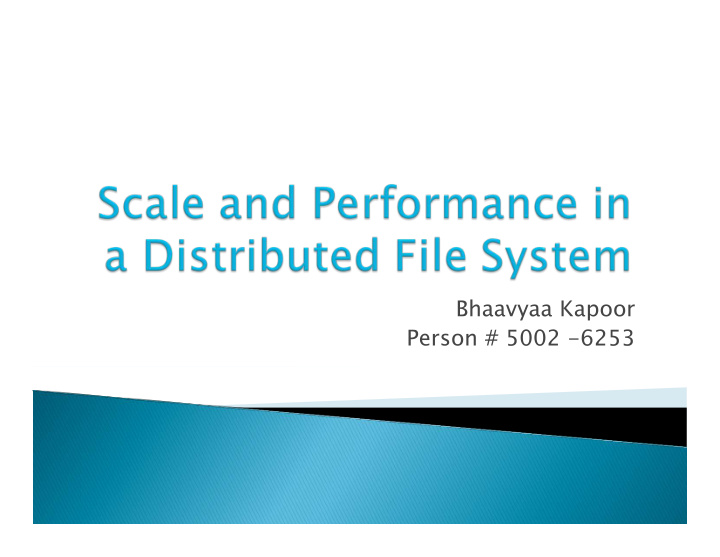



Bhaavyaa Kapoor Person # 5002 -6253
} Andrew File System } The Prototype } Changes for Performance } Effect of Changes for Performance } Comparison with A Remote-Open File System } Conclusion
} Joined project of Carnegie Mellon University & IBM } Distributed scalable file system with homogeneous, location-transparent file name space to all client workstations } Motivation behind AFS: Ability to scale to serve large no of clients without degradation in performance } Clients and servers run the 4.2 Berkeley Software Distribution(4.2 BSD)
Server: VICE -> Vast Integrated Computing Environment file system Client : Venus -> VIRTUE: Virtue is Reached Through Unix and Emacs Server 1 VICE Operating System Workstation 1 Workstation 2 VI readme.txt 2 6 2 5 7 4 1 Close Write (cache) callback Read (cache) open Open 3 close Operating System Operating System VENUS VENUS
} Venus on the client with a dedicated, persistent process } Dedicated lock server process } Each server stored the directory hierarchy ◦ Mirroring the structure of the Vice files ◦ .admin directory – Vice file status info ◦ Stub directory – portions of the Vice name space on other servers ◦ location database embedded in the file tree } Vice-Venus interface named by their full pathname } Cached copies were verified with server
} The performance was significantly degraded due to too much stat call involving cache validity check } Network resources in the kernel frequently exhausted due to excessive context switching } Location Database: Difficult to move users’ directories between servers } Unable to implement Disk quotas
} Cache management ◦ Cache Directories and symbolic links in addition to files ◦ Callback reduces cache validation traffic } Name resolution o Fid: Notion of two-level names with unique fixed- length o 32-bit components – Volume number, Vnode number, Uniquer } Communication and server process structure o Light weight process bound to a client for single server operation } Low level storage representation o Access files by their inodes
} Scalability ◦ The data in the table below shows that AFS is19% slower than stand-alone workstation ◦ Prototype is 70% slower ◦ Remarkable improvement in scalability ◦ CPU utilization increases from 8% at a load of 1 to 70% at load of 20
} Remote Open ◦ Fundamental property : The data in a file are not fetched en masse, instead the remote site potentially participates in each individual read an write operation It is called remote open since file is actually opened on the remote site rather than the local site ◦ Andrew under controlled conditions was compared to Sun Microsystem's NFS ◦ NFS performance degrades rapidly at increasing loads
At a load of 18, server CPU utilization saturates at 100% in NFS; in Andrew it is � 38% Andrew’s scaling characteristics are superior to those of NFS �
AFS NFS File Access Common name space from Different file names from ñ all workstations different workstations ñ File Location Automatic tracking by Mount points to files set by ñ Tracking file system processes administrators and users ñ and databases ñ Performance Client caching to reduce No local disk caching; ñ network load; callbacks limited cache consistency ñ to maintain cache consis- ñ tency ñ Andrew Average time of 210 Average time of 280 ñ Benchmark seconds/client seconds/client ñ Scaling Maintains performance in Best in small to mid-size ñ capabilities small and very large installations ñ installations ñ Security Kerberos mutual authen- Security based on tication unencrypted user ID's ñ ñ ñ
} AFS-1 - first prototype, used for statistics gathering in preparation of AFS-2 } AFS-2 – thread per client, call-back for cache consistency, local directory operations with write- through, introduction of volumes, read-only replication } AFS-3 – commercialization of AFS by Transarc Corp,; introduction of cells for a world wide unified name space, use of v-node interface, serious security using Kerberos, chunk-based transfer and caching } 16 Aug 2000: IBM announces Open AFS
OpenAFS is an open source implementation of AFS OpenAFS is extremely cross-platform. OpenAFS clients exist for small devices (e.g., the Nokia tablet) up to mainframes It is a client-server distributed file system. It has strong file consistency semantics based on its use of client-side caching and callbacks It provides a mechanism for replicated access to read-only data, without requiring any special hardware or additional high-availability or replication technology.
Recommend
More recommend